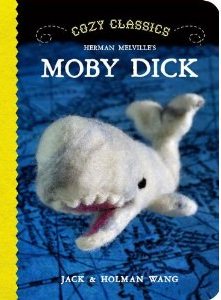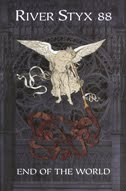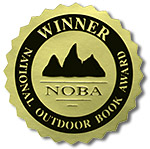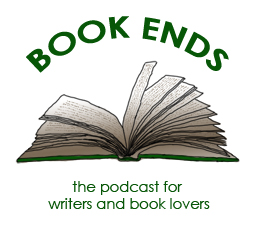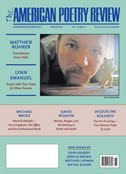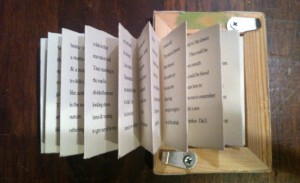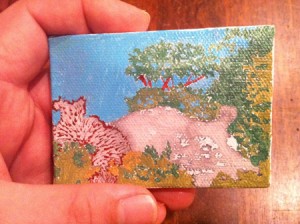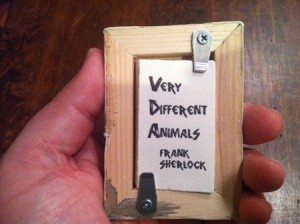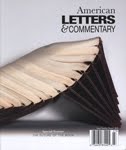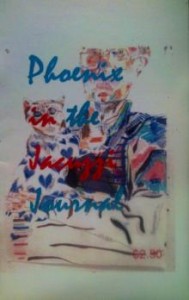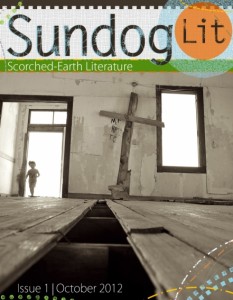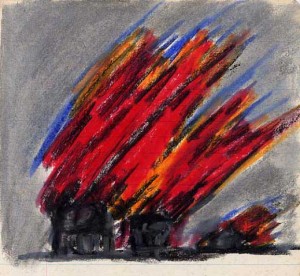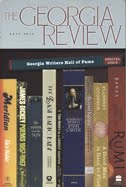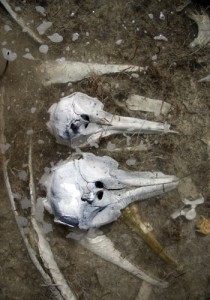Cozy Classics from Simply Read Books are a series of board books for children based on the classics Les Miserables (forthcoming), Pride and Prejudice, and Moby Dick. Each book contains twelve “child-friendly” words and twelve needle-felted photo illustrations. Brilliantly charming!
NewPages Blog
At the NewPages Blog readers and writers can catch up with their favorite literary and alternative magazines, independent and university presses, creative writing programs, and writing and literary events. Find new books, new issue announcements, contest winners, and so much more!
End of the World. End of the Book?
Supposedly, this is the year of the end of the world. Editor Richard Newman says, “The first books predicted the end of the world, and probably not long after, people began predicting the end of the book.” With the close of book publishers, magazines, and distributors, it’s easy to get downhearted about the situation, but Newman says he is not “singing the death song of the printed word.” He says, “Good literature will survive the trends and weather the storms and droughts, even if only a handful of people keep it alive and don’t surrender to the rapture of destruction.”
The most recent issue of River Styx is based on the theme of the end of the world. “In these pages we have presented the irrational struggle with the end of everything—our fear of the end at odds with our odd hope for it,” Newman says. Contributors include Bruce Bennett, Lee Upton, Albert Goldbarth, Juliana Gray, Gary Leising, Michael Salcman, Rachel Christilles, William Greenway, Dorianne Laux, Lawrence Raab, Alison Pelegrin, Maura Stanton, Michael Derrick Hudson, Erika Meitner, Greg Pape, Gaylord Brewer, Andrew Hudgins, Jeffrey Hammond, Robert Finch, George Singleton, and Geoff Schmidt.
In addition, the winners of the 2012 River Styx International Poetry Contest are included. The submissions were judged by A. E. Stallings, and the contest is in memory of Anne and James Lindsey.
First Place
Hailey Leithauser: “Minnows”
Second Place
Debra Marquat: “Ground Oregano”
Third Place
Brain Brodeur: “Cousins”
Honorable Mentions
Michael Derrick Hudson
Josephine Yu
Alison Pelegrin
Ryan Wilson
Spread the word!
Happy Thanksgiving
Please enjoy a safe and restful holiday weekend with family and friends. We’ll be back on the blog Monday.
Spread the word!
2012 Outdoor Book Awards Announced
Thinking about holiday shopping for the nature lover in your life? This year’s Outdoor Book Awards have been announced, and with the variety of categories in the awards, there’s something for everyone.
Spread the word!
BlazeVOX Thanksgiving Menu Poem 2012
The Thanksgiving Menu Poem 2012 is an annual online event, this year, featuring Guest of Honor: Bill Berkson.
From BlazeVOX [books]: “For two thousand and twelve we are celebrating with a twelve-course meal over twelve hours. This is a book length poetry project matched with haute cuisine, including a full biography of Bill Berkson with poems, links to more poems, reviews and interviews. The whole project will go live on Thanksgiving morning, so be sure to come and have a feast. Please feel free to invite your family, friends, and colleagues.”
Event Info
Date: Thanksgiving Day, November, 22 2012
Time: All day and will be up for the rest of the year
Online Address: www.blazevox.org/index.php/thanksgiving-poems/
Thanksgiving Menu Poems Past:
Keith and Rosmarie Waldrop 2011
David Shapiro 2010
C. D. Wright 2009
Anne Waldman 2008
Ron Silliman 2007
John Ashbery 2006
Robert Creeley 2005
Kent Johnson 2004
Forrest Gander 2003
Charles Bernstein 2002
Spread the word!
New Podcast :: Book Ends
Created by writer and award-winning blogger Philippa Moorem, Book Ends is a new weekly (Wednesdays) podcast by writers for writers and those who love the written word. Novels, poetry, travel writing, biographies, cook books and all manner of printed works will be discussed: writers in conversation about their work, their inspiration and their advice to those wanting to follow in their footsteps. The program is available online and via iTunes subscription.
Episode 1: Nikki Gemmell
Episode 2: Lisa Jewell
Episode 3: Ivy Alvarez
Spread the word!
Adrienne Rich on Anne Sexton
In the most recent issue of American Poetry Review, Lynn Emanuel, a former student of Adrienne Rich at City College in New York, shares a speech given by Rich during the year of Anne Sexton’s death. “The speech is typed on onionskin,” says Emanuel, “and stained by the tape I used for many years to attach it to the wall above my various desks.”
Emanuel says that 1974 was a “tumultuous year for Rich and her students.” It was the year Sexton killed herself, and it was about the time that Rich published her work Diving into the Wreck as well as came out as a lesbian feminist. Rich’s speech, given to the women in her college workshop, begins:
“Anne Sexton was a poet and a suicide. She was not in any narrow or politically ‘correct’ sense a feminist, but she did some things far ahead of the rebirth of the feminist movement. She wrote poems alluding to abortion, masturbation, menopause, and the painful love of a powerless mother for her daughters, long before such themes became validated by a collective of consciousness of women, and while writing and publishing under the scrutiny of the male literary establishment . . .”
The rest of the speech is printed in American Poetry Review, the November/December 2012 issue.
Spread the word!
Philip Roth Retires
During a recent interview, Philip Roth told French magazine Les Inrocks that he will retire from writing: “To tell you the truth, I’m done. Nemesis will be my last book.”
According to the Daily Star, Roth says he has spent most of his time in recent years preparing material for his biographer, Blake Bailey: “If I had a choice, I would prefer that there is no biography written about me, but there will be biographies after my death so [I wanted] to be sure that one of them is correct.”
Roth said he had asked his literary executors and his agent to destroy his personal archives after his death once Bailey has finished the biography. “I don’t want my personal papers hanging around everywhere.”
Spread the word!
Book Burning Party
Posted on BookFox (John Matthew Fox), this video shows Troy, Michigan’s risky approach to saving their public library. Could be role model for other cities with similar ballot proposals in the future.
Spread the word!
American Life in Poetry: Column 399
BY TED KOOSER, U.S. POET LAUREATE
Our sense of smell is the one sense most likely to transport us through time. A sniff of fried fish on a breeze and I can wind up in my grandmother’s kitchen sixty years ago, getting ready to eat bluegills. Michael Walsh, a Minnesotan, builds this fine poem about his parents around the odor of cattle that they carry with them, even into this moment.
Barn Clothes
Same size, my parents stained and tore
alike in the barn, their brown hair
ripe as cow after twelve hours of gutters.
At supper they spoke in jokey moos.
Sure, showers could dampen that reek
down to a whiff under fingernails, behind ears,
but no wash could wring the animal from their clothes:
one pair, two pair, husband, wife, reversible.
American Life in Poetry is made possible by The Poetry Foundation (www.poetryfoundation.org), publisher of Poetry magazine. It is also supported by the Department of English at the University of Nebraska-Lincoln. Poem copyright ©2010 University of Arkansas Press, from The Dirt Riddles by Michael Walsh, University of Arkansas Press, 2010. Reprinted by permission of Michael Walsh and the publisher. Introduction copyright © 2012 by The Poetry Foundation. The introduction’s author, Ted Kooser, served as United States Poet Laureate Consultant in Poetry to the Library of Congress from 2004-2006. We do not accept unsolicited manuscripts.
******************************
American Life in Poetry provides newspapers and online publications with a free weekly column featuring contemporary American poems. The sole mission of this project is to promote poetry: American Life in Poetry seeks to create a vigorous presence for poetry in our culture. There are no costs for reprinting the columns; we do require that you register your publication here and that the text of the column be reproduced without alteration.
Spread the word!
A Very Different Book
Is it a book? Is it a painting? It’s Very Different Animals by Frank Sherlock, an accordion-fold book set in fonts VTKS Animal 2 and Big Caslon and mounted in Blick Studio mini canvasses. Each canvas features original artwork by Philadelphia artist Nicole Donnelly. It is printed in an edition of 100 on reclaimed 120 gsm Arches cotton wove watercolor paper. It is officially available on Fact-Simile‘s website at a discounted pre-sale price.
Spread the word!
The Literary Review: The Long Issue
The Literary Review‘s Summer/Fall 2012 issue is subtitled “The Long Issue”: “Because some stories need room to grow.” Not typically done in the magazine world, this issue features only long poems and novellas.
Editor Minna Proctor says, “this issue’s theme came about because one of our contributors flagrantly ignored our submission guidelines and sent us a novella, which so roguishly intrigued us that we changed the guidelines so as to not interfere with the integrity of her winding story. We built an issue around her; a gesture of pure admiration. We built her a furious house of extraordinary writing.”
Included in this issue is poetry by H.L. Hix (“Aggression Cues”) and Joshua Weiner (“Rock Creek Park (II)”) and fiction by Kirstin Allio (“Quetzal”), Paula Bomer (“Inside Madeleine”), and Jesse Ball (“The Neck Verse”).
Spread the word!
The Future of the Book
The future of the printed book is a thought that is probably always at the backs of our minds, as writers, as editors, as readers. American Letters & Commentary‘s newest issue is dedicated to this very topic. “Will technology increase access to literature or restrict it to those who can afford new technologies?” ask Co-Editors Catherine Kasper and David Ray Vance. “Will paper bound books become art objects for antiquarians, restricted to museums and wealthy collectors? Will producing electronic media prove more or less hazardous to the environment as compared with paper production for printed books?”
This special issue features essays by Joan Retallack and Ander Monson on the subject, and Dimitri Anastasopoulos, Christine Hume, Dave Kress, and Christina Millettii contribute a collaborative piece titled “Story Net” which “examines the concept of ‘tomorrow.'”
And then there is contributing art by Brian Dettmer that you really have to see. He is a book artist. “The richness and depth of the book is universally respected yet often undiscovered as the monopoly of the form and relevance of their information fades over time,” he writes. “By altering physical forms of information and shifting preconceived functions, new and unexpected roles emerge.” He explains his process as such: “I work with knives, tweezers and surgical tools to carve one page at a time, exposing each layer while cutting around ideas and images of interest . . . My work is a collaboration with the existing material and its past creators and the completed pieces expose new relationships of the book’s internal elements exactly where they have been since their original conception.”
Other poetry and prose contributors in the rest of the issue include Eric Anderson, Hadara Bar-Nadav, Denise Bergman, Thea Brown, Jennifer Chapis, Suzanne Cleary, Elizabeth Cross, Jesse DeLong, Dan George, AB Gorham, Richard Greenfield, Derek Gromadzki, Kathleen Hellen, Russell Jaffe, Christopher Kondrich, Brandon Krieg, Jason Labbe, Megan Levad, rob mclennan, B.Z. Niditch, Simon Perchik, Marthe Reed, John Phillip Santos, Anne Shaw, Kent Shaw, Carmen Gim
Spread the word!
New Lit on the Block :: Phoenix in the Jacuzzi Journal
“What if a phoenix were to ignite in a Jacuzzi? Would anyone notice? Would the phoenix be reborn?” These are the questions that Editor Nicholas Wilsey asks. “I like to think the phoenix would reenter the world in a state of relaxation: a cool drink in its beak; a warm, bubbly feeling climbing up its wings,” he says. And thus, the name of his new literary magazine was born.
Phoenix in the Jacuzzi Journal is a print magazine that publishes at least twice a year in the spring in the fall. There is a possibility of having multiple issues in the spring and fall or a special issue in the winter and summer. They publish poems and short prose pieces.
“I am beginning to talk with other journals about doing a joint reading on the poetry-focused radio show I DJ, The Eggshell Parade,” Wilsey says. “I also intend to do an issue that includes a CD of musical adaptations of the issue’s pieces. I am going to have a lot of fun with PJJ. I invite readers and contributors to have a lof of fun with PJJ, Joe (Weil, Consigliere), and me.”
The inaugural issue features new writing from Grace Bauer, Adam Fitzgerald, Howie Good, Michael Homolka, Paul Hostovsky, Bridget Lowe, Andrew Nurkin, K.M.A. Sullivan, and Anne Valente.
PJJ accepts submissions through email. Authors whose work is accepted are invited to read on The Eggshell Parade.
Spread the word!
Alligator Juniper – 2012
Like the magazine, the alligator juniper tree is native to Arizona (the journal is a yearly publication of Prescott College), but, as its unusual name implies, the magazine “invites both the regional and the exotic.” What sets this journal apart from other lit mags is that the only avenue for submission—open to all levels, emerging, early-career, and established—is through their national contests. These include a general one for fiction, creative nonfiction, poetry, and photography, and a separate Suzanne Tito contest for fiction, CNF, and poetry. The prizewinners and finalists selected for this issue are supremely worth reading. Continue reading “Alligator Juniper – 2012”
Spread the word!
American Letters & Commentary – 2012
American Letters & Commentary defines itself as “innovative,” “challenging,” “daring,” and “diverse.” In this issue, John Phillip Santos reviews the poetry of John Matthias, saying that his “work imbeds us in his mind’s ceaseless flow of intimate memories, archival citations, insurrectionary readings, free associations and liberated play that seeks to unsettle the unexamined phenomenology of the reader’s attention to the world.” These phrases characterize ALC 23 as a whole. Continue reading “American Letters & Commentary – 2012”
Spread the word!
American Literary Review – Spring 2012
In The Proceedings of the Natural Academy of Sciences of the United States of America (January, 2006), researchers argue that “emotion enhances remembrance of neutral events past.”1 Investigators speculated that the reason for this might have to do with more pointed attention during the coding process or enhancement after the event, but what they showed more centrally was that emotion enhances long-term memory, “determining what will later be remembered or forgotten.”2 Virginia Woolf wrote in her journal that there was a certain advantage to memory stripped of its emotional coloring, which doesn’t contradict the recent claim of the Academy, but adds to the complexity of the relationship between memory and emotion which would have considerable impact on literature and its sibling sciences—the law and psychology. Continue reading “American Literary Review – Spring 2012”
Spread the word!
Beloit Poetry Journal – Fall 2012
Whenever I review a poetry journal, I look for one or two poems that stitch all the poems to each other and, ultimately, to the fabric of my conscience. I trust the editors, whenever possible, to produce a publication that ties itself together with a common theme, a certain style, or a period in literary history, to name a few of the devices at an editorial team’s disposal. If I leave myself open to all the ways that such a “stitching” can happen, I am almost always pleased—as I am with the Fall 2012 Beloit Poetry Journal, which is a gem of a journal. The poem “Above the Lake,” by Stephen O’Connor, manages to pull the journal together. Continue reading “Beloit Poetry Journal – Fall 2012”
Spread the word!
Blue Mesa Review – Spring 2012
Blue Mesa Review, a product of the creative writing program of the University of New Mexico, almost did not see publication this year. Editor-in-Chief Suzanne Rose Richardson reports that her fellow editors had to fight to keep their magazine alive during their school’s funding crisis: “They organized fund raisers, attended countless meetings, and they brainstormed in order to bring you this very issue you’re holding. Each editor gave above and beyond to ensure this issue had a chance to make it.” The folks at Blue Mesa have a lot to be proud of in this issue. The result of their hard work and dedication is a handsome journal with great content. Continue reading “Blue Mesa Review – Spring 2012”
Spread the word!
Chinese Literature Today – 2012
In his editor’s Note, Deputy Editor-in-Chief Jonathan C. Stalling explains that part of the publication’s mission is to offer “to non-experts a multifaceted portal into contemporary China through literature and literary studies.” To do this, he refers readers to the issue’s featured scholar, Yue Daiyun, whose work in comparative literature has led to the conclusion that the traditions of the West and those of China (Confucianism, Daoism, and Buddhism) no longer exist independently of the other. Indeed, as Stalling explains, Yue’s vision is one in which comparative literature is preparation for “an era of global multicultural coexistence.” Continue reading “Chinese Literature Today – 2012”
Spread the word!
Harvard Review – 2012
Reading the Harvard Review was a pleasure. I could read this journal anyway I liked. I could freefall, flipping forward fifty pages at a whim, and know whichever piece I landed on would catch me. The obvious wow-factors include Spain’s poet laureate, Vincente Aleixandre; Antoni Tàpies, a Catalan painter whose work has been displayed at the most prestigious museums around the world; and Charles Simic, a Pulitzer Prize winner and MacArthur Fellowship recipient. Continue reading “Harvard Review – 2012”
Spread the word!
Jubilat – 2012
Jubilat 21 is an eclectic issue packed with both surrealism and honesty, insight and fun. I’ve always loved jubilat for the bold, inventive work it features, and this issue is no exception. Continue reading “Jubilat – 2012”
Spread the word!
The Labletter – 2012
The Labletter is the product of a small group of artists in Oregon who wrote together for ten years before inviting formal submissions. At its core, the Lab was a place where artists could experiment with their work and benefit from the group’s diverse mediums. The journal’s fourth annual issue stays true to its Oregon Lab roots—it is steeped in nature, whether captured by the photographer, the novelist, the poet, or the painter. Continue reading “The Labletter – 2012”
Spread the word!
The Los Angeles Review – Spring 2012
This issue of The Los Angeles Review is packed with nonfiction, fiction, poetry, interviews, reviews, and even a special feature on John Rechy. At just under 300 pages, it is truly a wonder how the editors were able to include so many genres and forms. Rechy was impossibly lucky to have the first piece of fiction he submitted be published. He was a gay hustler who needed physical affection, even after becoming a successful writer. His writing is poignant, vivid, and mesmerizing, here is a little taste included in the magazine: Continue reading “The Los Angeles Review – Spring 2012”
Spread the word!
Palooka – 2012
The cover art for this issue—“The Little Prince” by Andrew Robertson—speaks greatly to the aura of the writing held within. The Little Prince stands on his asteroid, back turned to us, with just his rose. The fiction, poetry, and nonfiction held within the magazine emit these same senses of loneliness and solitude, though in a way that is both beautiful and poetic. Continue reading “Palooka – 2012”
Spread the word!
Redivider – 2012
Redivider releases their spring 2012 issue loaded with a mix of strong and diverse works of fiction and poetry. From the absurd to the tragic, this issue was a pleasure to read from beginning to end. Continue reading “Redivider – 2012”
Spread the word!
Rhino – 2012
It’s Rhino. I don’t know how long it’s been around, but it is one of the best annual collections of poetry you can find. Once you know the quality is there, what would you like me to tell you? It’s always good. If you are not familiar with it, you can count on it to enrich your day and entertain your evening. If you are familiar with it, you look forward to it. So, what did I do? Continue reading “Rhino – 2012”
Spread the word!
Sakura Review – Spring 2012
Upon reading Volume III of Sakura Review, I had an immediate interest in finding out what the word “Sakura” referred to. I, of course, went first to Wikipedia where I learned that “sakura” might refer to “the Japanese term for ornamental cherry blossom trees and their blossoms.” Continue reading “Sakura Review – Spring 2012”
Spread the word!
Southern Humanities Review – Summer 2012
When money’s involved, what constitutes a document can be volcanically contested. Prior drafts, letters of intent, symbols sketched on a corner of a tablecloth are material one way or the other, if at all. Not so with every literary magazine. The summer 2012 issue of Southern Humanities Review is the first out of maybe twelve issues that I’ve reviewed that is curiously harmonic, down to the detailed footnotes of an essay. The Minutes of the Executive Board Meeting of the Southern Humanities Council, the copyright attribution on the last page from November 1931 are allusive, contributing to a cohesive whole, teasing, in the vein of a modern Nabokov, what is real, what is to be believed. Continue reading “Southern Humanities Review – Summer 2012”
Spread the word!
upstreet – 2012
What makes the lit mag experience special? Editor Vivian Dorsel provides one interesting answer in the short introductory essay that opens this issue of upstreet. Dorsel describes the experience of arriving in Bermuda for a vacation. The narrow Bermudan roads wind you “through a landscape both commonplace and exotic—simple cottages and family homes and forms and hues foreign to your native New England, palm trees in myriad sizes, shapes and shades of green whose fronds clatter in the gusty wind . . .” upstreet creates a similar experience, introducing the reader to unexpected people and places that are nonetheless familiar. Continue reading “upstreet – 2012”
Spread the word!
Printer’s Devil Review – Fall 2012
In an introduction to this issue’s featured artist—Caleb Cole—Joshi Radin discusses how Cole takes old group photographs and whites out all people but one. “We focus on this individual,” writes Radin, “plucked from the crowd. Confined by the white space where companions once crowded, she is alone even in the company of others.” Take, for example, “There Yet,” in which you can see a young girl’s blank expression, barely visible. It may have been lost in the photo originally, blocked out by the other children. Each of the photographs emits loneliness, solitude. “As a group,” Radin says, “They are all alone together.” The pieces of writing contained in this issue speak that same message to me. Continue reading “Printer’s Devil Review – Fall 2012”
Spread the word!
Fogged Clarity – November 2012
This issue of Fogged Clarity contains poetry, one piece of fiction, music, an interview, and a review. At first, I was concerned about there being so little in the issue (not realizing at first its monthly publication cycle), but each piece is strong and worth reading. Continue reading “Fogged Clarity – November 2012”
Spread the word!
Per Contra – Fall 2012
Per Contra‘s fall issue offers a varied sampling of fiction, nonfiction, poetry, and visual art. Continue reading “Per Contra – Fall 2012”
Spread the word!
The Medulla Review – 2012
Before you read The Medulla Review, take everything you think you know about our world and throw it out the window; the stories contained within the issue will challenge new ways to think about the way it actually works. You’ll discover a world in which all men turn, quite literally, into pigs; you’ll meet a man who removes, again quite literally, the faces of women before he can sleep with him; you’ll be introduced, in biography form, to Judas Horse, the world’s greatest cheese artist (“he is best known for his map sculptures of each of the fifty United States and territories of Puerto Rico, Guam and the USVI done entirely in cheese, chewed into shape by his own unique teeth”); and you’ll even find yourself navigating a maze as a lonely lab rat. Continue reading “The Medulla Review – 2012”
Spread the word!
The Fib Review – October 2012
Hear the name The Fib Review and you may think it is a journal dedicated to literature about lies. But actually, it showcases a unique form of poetry—the Fibonacci poem. Based off of the Fibonacci sequence (0, 1, 1, 2, 3, 5, 8, 13 . . . or Fn = Fn-1 + Fn-2), the poems use the number of words or syllables on a line to build the pattern, making the journal a wonderful creative outlet for math-lovers. Continue reading “The Fib Review – October 2012”
Spread the word!
On the Premises – November 2012
Populated by winners of each contest, each issue of this magazine has a different premise. This issue includes three winners and three honorable mentions on the premise of time. At first, I wasn’t looking forward to the pieces, expecting the classic race against time scenario, but I was pleasantly surprised to see time handled in a much different way. Continue reading “On the Premises – November 2012”
Spread the word!
Goblin Fruit – Autumn 2012
To set the feel for the rest of the issue, the editors of Goblin Fruit start it off with the haunting image of “The Vigil” by Mike Allen (for a visual of this “woman,” check out the art by Elisabeth Heller for the issue): “Where her eyes affix cannot be guessed. / Beneath a hat of iron wire / hang tattooed skins that veil her face.” Reading the rest of the issue, you’ll get the sense that she is watching you: Continue reading “Goblin Fruit – Autumn 2012”
Spread the word!
Halfway Down the Stairs – September 2012
This issue of Halfway Down the Stairs, the “Chaos” issue, features poetry, fiction, and nonfiction that have been written, as Editor Joseph Murphy says, by overcoming “chaos, distraction, frustration and more.” Continue reading “Halfway Down the Stairs – September 2012”
Spread the word!
The Writing Disorder – Fall 2012
If you’re looking for a great amount of reading packed into one issue, look no further than the latest issue of The Writing Disorder. And this issue is even larger than their typical issue, expanded to accommodate even more writing. Continue reading “The Writing Disorder – Fall 2012”
Spread the word!
Digital Americana – Fall 2012
Digital Americana is living up to its name; it is redefining literary magazines in the digital world and ever enhancing the reading experience. This special “Redact” issue encourages breathing new air into the writing already published there. Continue reading “Digital Americana – Fall 2012”
Spread the word!
The Bacon Review – October 2012
Although the November issue went live literally minutes after I finished reading this issue, I urge you to excuse the fact that this review is for the October issue. The October issue marks the magazine’s one year anniversary, and I figured it needed a celebration. And there’s a lot to celebrate here. Continue reading “The Bacon Review – October 2012”
Spread the word!
Five Quarterly – October 2012
For each issue, Five Quarterly publishes five poems and five pieces of fiction, all selected by five judges (which also change with each quarter). The judges for this issue are Stephen Paul Miller, Fernando Perez III, Jasmin Rosario, Cheryl Wilson, and Tiphanie Yanique. Continue reading “Five Quarterly – October 2012”
Spread the word!
NewPages Magazine Stand – November 2012
Got a bookstore or library near you with dozens of new lit and alt mags on the racks? Yeah, me neither, which is why we created the NewPages Magazine Stand for information about some of the newest issues of literary and alternative magazines. The Magazine Stand entries are not reviews, but are descriptions provided by the sponsor magazine. Sometimes, we’ll have the newest issue and content on our site before the magazine even has it on theirs. Good reading starts here!
Spread the word!
Sips Cards
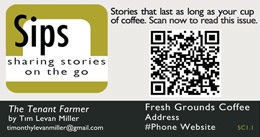 Sips Cards puts short (“lasts as long as a cup of coffee”) fiction and poetry into local coffee shop venues around the country (and in Scotland). Sips Cards is a publication run by artists, for artists. Each business card contains a QR code, loaded with a short story, or set of poems, from a writer meant to last as long as a cup of coffee. The cards include the issue’s author, story title, and website/e-mail.
Sips Cards puts short (“lasts as long as a cup of coffee”) fiction and poetry into local coffee shop venues around the country (and in Scotland). Sips Cards is a publication run by artists, for artists. Each business card contains a QR code, loaded with a short story, or set of poems, from a writer meant to last as long as a cup of coffee. The cards include the issue’s author, story title, and website/e-mail.
A QR code is free media media accessible with a barcode reader on any smart-type device, such as smartphones, iPods and iPads equipped with cameras, and other barcode scanning software. RedLaser and Barcode Scanner are two common, well reviewed apps, that are free to download and install on devices. These apps are easy to use and will also read typical linear barcodes.
A list of venues where Sips Cards can be found is available on the publication website, as well as contact information for letting Sips Cards know of a venue near you where you’d like to see the cards available.
Submissions for the Winter Issue (January) will be open through Friday, December 7th. The Winter Issue will contain two short story cards (each with one short story) and two poetry cards (each with one poem). There is a fee for submissions; authors whose works are selected receive payment.
Spread the word!
New Lit on the Block :: Sundog Lit
Sundog Lit is a brand new online magazine (which I recently reviewed on Screen Reading) that quarterly publishes literary fiction, creative nonfiction, poetry, and hybrid works as well as occasional video, photography, and art. “We started this magazine because we were tired of quiet lit, stories where nothing happens and people stand around, idle, wondering about life instead of living it,” says Managing/Founding Editor Justin Lawrence Daugherty. “Our mission is to publish literature that scorches the earth. We don’t want quiet. We want it loud and incendiary.”
The name comes from an atmospheric phenomenon in which bright spots of light appear in the sky near the sun, sometimes making it seem as if the sun were wearing a halo. Daugherty says that this dual-sun image was perfect to describe their magazine, one in which was about both serious literature and about being “active, destructive, generating, and explosive.”
The editors aim to leave an imprint on their readers, allowing the literature to stick with them even after the internet browser is closed. Daugherty also expresses that readers will find a community of writers. “We promote work through our Friday Rex series, book-promotions such as in our current Texts Inspired by Robert Kloss’ The Alligators of Abraham series.” In time, they hope to bring in more hybrid works and experimental essays, photography and art, contests, and themed issues.
The first issue includes fiction from Lindsay Hunter, Casey Hannan, Aaron Teel, Ryan Werner, Edward Hagelstein, Helen McClory, and Jesse Hertz; nonfiction from Matthew Gavin Frank, Laura Zak, and Will Kaufman; and poetry from Bianca Diaz, Sarah Wynn, Donald Parker, Jenna Lynch, Cameron Witbeck, Daniel Romo, Charles Rafferty, and Valentina Cano.
The deadline for the next issue is mid-January, and Sundog Lit accepts submissions through Submittable. The other editors of the magazine include Fiction Editor Mensah Demary, Nonfiction Editor Richard Hackler, Poetry Editors Zarah Moeggenberg and Amy Pajewski, and Website Design and Nonfiction Editor Cynthia Brandon Slocum.
Spread the word!
Broadsided: Responses to Superstorm Sandy
Moved by the plight of people affected by Superstorm Sandy, Brooklyn-based Broadsided artist Ira Joel Haber created the image featured here. Broadsided now asks writers to respond with words for Superstorm Sandy 2012. The editors will select the best responses and publish the resulting collaboration(s) with their December Broadsided feature, a pdf poster download. This is Broadsided’s second “Responses” feature. The first was to the 2011 earthquake and tsunami in Japan. Deadline for submissions: November 20.
Spread the word!
Georgia Writers Hall of Fame
The Georgia Writers Hall of Fame, established in 2000 as part of the Hargrett Rare Book and Manuscript Library, highlights authors who are either from Georgia or who have produced a significant piece of work while in Georgia. Among these writers are some very well-known names, but all of the writers’ works “reflect the character of the state—its land and people.” This fall, the Hall of Fame is celebrating its new home in the new Richard B. Russell Special Collections Building.
In accordance with this, The Georgia Review has put out a special fall issue to highlight the work of these authors. The writing included in this issue spans a timeline, and Editor Stephen Corey urges you to read it in order: “you will welcome the experience of observing the historical shifts of style, subject, tone, and even spelling and punctuation across nearly two centuries.” They were not able to highlight all forty-three current members, but they were able to feature thirty-two.
These writers include Augustus Baldwin Longstreet, Elias Boudinot, Sidney Lanier, John Chandler Harris, W.E.B. Du Bois, Georgia Douglas Johnson, Conrad Aiken, Jean Toomer, Lilian Smith, Ralph McGill, Erskine Caldwell, Johnny Mercer, John Oliver Killens, Carson McCullers, Byron Herbert Reece, Calder Willingham, James Dickey, Jimmy Carter, Flannery O’Conner, Robert Burch, Raymond Andrews, Harry Crews, John Stone, Coleman Barks, Terry Kay, James Kilgo, Alice Walker, David Bottoms, Philip Lee Williams, Judith Ortiz Cofer, Melissa Fay Greene, and Natasha Trethewey.
Spread the word!
Writers on Writing :: Glimmer Train Bulletin #70
The November issue of Glimmer Train’s eBulletin features craft essays by writers whose works have recently appeared in Glimmer Train Stories: Natalie Sypolt writes on “The Risk, the Reward of ‘Writing What You Know'”; Josh Henkin writes on “Consequence and Agency in Fiction”; Maggie Shipstead writes on “Focus”; David Ebenbach writes “Turquoise Shoes: Short Stories Care About the Little Things.” The bulletin is a free, monthly publication.
Spread the word!
Flyway Soars Online
Managing Editor Chris Wiewiora let us know that Flyway: Journal of Writing and Environment will be moving fully online as a literary magazine after their final print issue, which Wiewiora refers to as “a tome of an anthology.” Flyway will continue publishing online on a rolling basis. They hope to launch the new site around AWP 2013 – so stay posted.
In addition, Flyway has extended the deadline for their Notes from the Field contest, “a non-fiction contest celebrating writing about experience — whether that be abroad, on a familiar sidewalk, in one’s line of work, in a field of interest, or in the most unexpected of times and settings.” The catchphrase this year is: “Get your hands dirty!” Featuring guest judge, travel and non-fiction writer, Rolf Potts. Deadline: November 12
Spread the word!
American Life in Poetry: Column 398
American Life in Poetry
By Ted Kooser, U.S. Poet Laureate
David Hernandez is a Californian who knows how to have a good time with his writing. Here’s a delightful flight of fancy based on a negotiation with a postal clerk.
At the Post Office
The line is long, processional, glacial,
and the attendant a giant stone, cobalt blue
with flecks of white, I’m not so much
looking at a rock but a slab of night.
The stone asks if anything inside the package
is perishable. When I say no the stone
laughs, muted thunderclap, meaning
everything decays, not just fruit
or cut flowers, but paper, ink, the CD
I burned with music, and my friend
waiting to hear the songs, some little joy
after chemo eroded the tumor. I know flesh
is temporary, and memory a tilting barn
the elements dismantle nail by nail.
I know the stone knows a millennia of rain
and wind will even grind away
his ragged face, and all of this slow erasing
is just a prelude to when the swelling
universe burns out, goes dark, holds
nothing but black holes, the bones of stars
and planets, a vast silence. The stone
is stone-faced. The stone asks how soon
I want the package delivered. As fast
as possible, I say, then start counting the days.
American Life in Poetry is made possible by The Poetry Foundation (www.poetryfoundation.org), publisher of Poetry magazine. It is also supported by the Department of English at the University of Nebraska-Lincoln. Poem copyright ©2011 by David Hernandez from his most recent book of poems, Hoodwinked, Sarabande Books, 2011. Reprinted by permission of David Hernandez and the publisher. Introduction copyright © 2012 by The Poetry Foundation. The introduction’s author, Ted Kooser, served as United States Poet Laureate Consultant in Poetry to the Library of Congress from 2004-2006. We do not accept unsolicited manuscripts.
[]American Life in Poetry provides newspapers and online publications with a free weekly column featuring contemporary American poems. The sole mission of this project is to promote poetry: American Life in Poetry seeks to create a vigorous presence for poetry in our culture. There are no costs for reprinting the columns; they do require that you register your publication online and that the text of the column be reproduced without alteration.]

